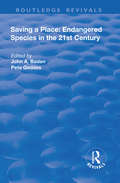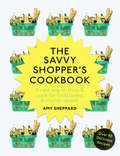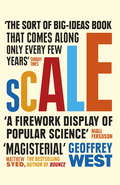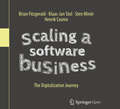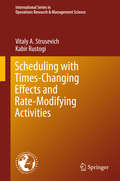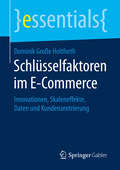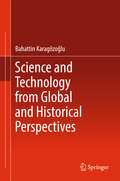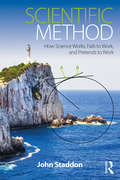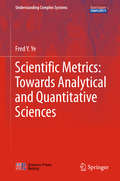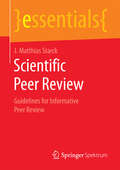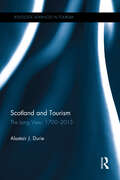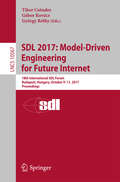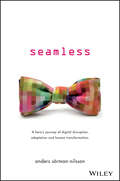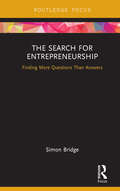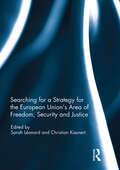- Table View
- List View
Saving a Place: Endangered Species in the 21st Century
by John A. Baden Pete GeddesThis title was first published in 2000: The noble goals embodied in the Endangered Species Act are colliding with financial and social realities. Citizens increasingly face the costs of current policies, while initiatives which fail to respect liberty and property meet serious resistance at every turn. Despite widespread verbal support for saving species ’at any cost’, when trade-offs become obvious, and values compete, support for these policies evaporates. This edited collection examines ethically and materially responsible approaches to this problem, written by leading international figures from a variety of disciplines. The result is the most comprehensive and constructive analysis of the effectiveness and viability of endangered species protection available.
The Savvy Shopper’s Cookbook
by Amy Sheppard<p>If you love delicious food, spending less on your weekly shop and saving time, this cookbook is for you! <p>This book will show you how to navigate discount supermarkets and shop for fewer ingredients at low prices, without compromising on your favourite meals, flavour or satisfaction! <p>Packed with delicious, cheap and nutritious midweek meal ideas to match your shopping habits, this might just be the book you’ve been searching for. <p>Open up for mouth-watering dishes including Caramelised Onion and Goat’s Cheese Tart, Steak and Potato Salad with Creamy Horseradish Dressing, Moroccan Chickpea Curry, and 15-minute Apple and Blackberry Crumbles.</p>
Scale: The Universal Laws of Life and Death in Organisms, Cities and Companies
by Geoffrey WestGeoffrey West's research centres on a quest to find unifying principles and patterns connecting everything, from cells and ecosystems to cities, social networks and businesses.Why do organisms and ecosystems scale with size in a remarkably universal and systematic fashion?Is there a maximum size of cities? Of animals and plants? What about companies?Can scale show us how to create a more sustainable future?By applying the rigour of physics to questions of biology, visionary physicist Geoffrey West found that despite the riotous diversity in the sizes of mammals, they are all, to a large degree, scaled versions of each other. This speaks to everything from how long we can expect to live to how many hours of sleep we need. He then made the even bolder move of exploring his work's applicability to cities and to the business world. These investigations have led to powerful insights about the elemental natural laws that bind us together in profound ways, and how all complex systems are dancing to the same simple tune, however diverse and unrelated they may seem.
Scaling a Software Business: The Digitalization Journey
by Brian Fitzgerald Klaas-Jan Stol Sten Minör Henrik CosmoThis book is open access under a CC BY 4.0 license.This book is intended primarily for practitioners who are facing the “softwareisation” of their business. It presents the Scaling Management Framework, a model based on collected experiences from companies that have already made the journey to give software a central role within the organization. The model is unique because it suggests a holistic method to analyze and plan your journey. It simply means that you can’t just focus solely on your products or services. You also have to look closely at your processes and your organization, the way you make decisions and get things done. Inevitably, these will have to change.Software has changed the rules of the game. The world talks about the digitalization in industry and society – how the focus has shifted from producing tangible things towards software and services. This trend started many years ago, but is now affecting every company, whether it’s a software company or not. There are many companies that have already made a digitalization journey – and many are about to embark on this journey – like you. How do you transform your organization when software is becoming a critical part of your business?This book comes with a map, a compass, and suggested journeys along with selected travel stories comprising best practices and lessons learned from past digitalization journeys. Use the map to find your way in the digitalization landscape, and use the compass to find the direction of your journey.
Scheduling with Time-Changing Effects and Rate-Modifying Activities (International Series in Operations Research & Management Science #243)
by Vitaly A. Strusevich Kabir RustogiIn scheduling theory, the models that have attracted considerable attention during the last two decades allow the processing times to be variable, i.e., to be subjected to various effects that make the actual processing time of a job dependent on its location in a schedule. The impact of these effects includes, but is not limited to, deterioration and learning. Under the first type of effect, the later a job is scheduled, the longer its actual processing time becomes. In the case of learning, delaying a job will result in shorter processing times. Scheduling with Time-Changing Effects and Rate-Modifying Activities covers and advances the state-of-the-art research in this area. The book focuses on single machine and parallel machine scheduling problems to minimize either the maximum completion time or the sum of completion times of all jobs, provided that the processing times are subject to various effects. Models that describe deterioration, learning and general non-monotone effects to be considered include positional, start-time dependent, cumulative and their combinations, which cover most of the traditionally used models. The authors also consider more enhanced models in which the decision-maker may insert certain Rate-Modifying Activities (RMA) on processing machines, such as for example, maintenance or rest periods. In any case, the processing times of jobs are not only dependent on effects mentioned above but also on the place of a job in a schedule relative to an RMA. For most of the enhanced models described in the book, polynomial-time algorithms are presented which are based on similar algorithmic ideas such as reduction to linear assignment problems (in a full form or in a reduced form), discrete convexity, and controlled generation of options.
Schluss mit 08/15-Websites – so bringen Sie Ihr Online-Marketing auf Erfolgskurs: 79 Tipps für Ihren Online-Auftritt
by Bastian SensDieses Buch zeigt Ihnen, wie Sie mit einer optimierten Website und Online-Marketing den Erfolg Ihres Unternehmens in die Hand nehmen können. Tipps und Tricks aus der Praxis helfen Ihnen, nicht nur im Kampf um die besten Google-Platzierungen ganz oben mitzumischen, sondern auch langfristig Kunden zu gewinnen und zu binden. Denn Hand aufs Herz: Können Sie sich erinnern, welche Websites Sie gestern besucht haben? Es dürften sehr wenige sein, und das ist kein Wunder. Denn während sämtliche Unternehmen im Web mit oft wenig überzeugenden Inhalten um unsere Aufmerksamkeit buhlen und immer noch mit nervigen Bannern oder Pop-ups um Kunden kämpfen, wenden wir uns genervt ab. Erinnern können wir uns höchstens daran, dass es mal wieder Zeit war, eine Seite zu schließen. Nur ganz wenige Unternehmens-Websites hinterlassen einen positiven und bleibenden Eindruck. Schade eigentlich.Machen Sie Schluss mit 08/15-Websites. Nutzen Sie das Expertenwissen von Online-Marketing-Profi Bastian Sens und geben Sie mit diesen 79 Tipps Ihrem Auftritt im Web eine persönliche Note. Entwickeln Sie eine markante Website, an die sich die Besucher auch morgen noch gerne erinnern.Handlich, leicht verständlich und vor allem praxisnah – Bastian Sens gibt 79 Tipps, die jederzeit leicht umgesetzt werden können.Tina Bergner – Marketing, Ducati Motor Holding S.p.A. Eine gute Website berührt den Kopf, den Bauch und das Herz eines Kunden und erweckt so die eigene Marke zum Leben. Bastian Sens gibt sein Praxiswissen weiter, damit auch Sie Ihre Website zum Leben erwecken können.Prof. Dr. Hanns-Ferdinand Müller – Vorstand der FORIS AG
Schlüsselfaktoren im E-Commerce: Innovationen, Skaleneffekte, Daten und Kundenzentrierung (essentials)
by Dominik Große HoltforthDas essential zeigt, wie digitale Innovationen, Customer Centricity, Skaleneffekte und Data Driven Marketing zu nachhaltigen Kundenbeziehungen und Wettbewerbsvorteilen im E-Commerce führen. Dazu werden die vier Schlüsselfaktoren im E-Commerce umfassend dargestellt. Leser und Leserinnen erhalten grundlegende Impulse für die Neuausrichtung von Geschäftsmodellen, zur Gestaltung von Wachstumsprozessen und zur Erzielung nachhaltiger Erträge. Das essential geht dabei über die übliche Auflistung von operativen To-dos hinaus und zeigt Faktoren auf, die digitalen Technologien und E-Commerce zu disruptiver Wirkung verhelfen.
Schutz von Unternehmensdaten bei der Erbringung von E-Services: Rechtliche, technische und organisatorische Lösungsansätze für Unternehmen des Maschinen- und Anlagenbaus
by Esther BollhöferEsther Bollhöfer betrachtet in diesem Buch weitgehend ungeklärte Fragen der Nutzung von Betriebsdaten bei der Erbringung von E-Services. Hierbei stehen rechtliche, technische und organisatorische Möglichkeiten des Schutzes von Informationen und Daten durch Unternehmen des Maschinen- und Anlagenbaus im Zentrum. Leitend ist stets der strategisch unternehmerische Blickwinkel, der eine Entscheidung anhand eines komplexen Gesamteindrucks der (Risiko-)Situation fällt.
Schwerbehindertenrecht in der Praxis: Übersichtliches Grundlagenwissen für Studierende sowie für Arbeitgeber, HR-Verantwortliche und Menschen mit Behinderung
by Andreas Wien Normen Franzke Constanze KovalevDiese übersichtliche und verständliche Einführung in die Grundstrukturen des Schwerbehindertenarbeitsrechts ist als Praxislehrbuch konzipiert, das sich zum Studium ebenso wie als ideales Nachschlagewerk für Arbeitgeber, HR-Verantwortliche und Arbeitnehmer anbietet. Insbesondere Arbeitgeber, die behinderte, schwerbehinderte Personen oder ihnen gleichgestellte Personen beschäftigen, müssen bei Einstellung, Prävention, Personalentwicklung und Kündigung von Menschen mit Einschränkungen den gesetzlichen Regelungen genau entsprechen. Dieses Lehrbuch vermittelt das notwendige Grundlagenwissen. Viele Mustertexte, Beispielrechnungen und Praxisfälle helfen zum besseren Verständnis und steigern den Praxiswert der Darstellung.
Schwierige Menschen am Arbeitsplatz: Handlungsstrategien für den Umgang mit herausfordernden Persönlichkeiten
by Heidrun Schüler-Lubienetzki Ulf LubienetzkiDieses Buch hilft Berufstätigen beim Umgang mit schwierigen oder gar gefährlichen Kollegen, Mitarbeitern oder Vorgesetzten. Manche Menschen vergiften die Arbeitsatmosphäre, machen andere Menschen krank und kosten ihre Unternehmen sehr viel Geld. Oft liegt die Ursache in einer psychischen Auffälligkeit, wir haben es dann häufig mit Narzissten oder Psychopathen zu tun, meistens liegt dem zerstörerischen Verhalten jedoch (noch) keine psychische Störung zugrunde. Dieses Buch führt einen Sammelbegriff für solche Menschen ein – es bezeichnet sie als „Toxiker“ – und hilft sowohl Betroffenen als auch Verantwortlichen in Unternehmen und Organisationen, diese zu erkennen, sich und andere vor ihnen zu schützen sowie erfolgversprechend gegen sie vorzugehen. Neben Hinweisen zu typischen Erkennungsmerkmalen von „Toxikern“ werden deren Motive erklärt und konkrete Handlungsstrategien und Beispiele erprobter Hilfestellungen vermittelt. Ein neues Kapitel liefert anschauliche, spannende Fallbeispiele aus der Praxis. Ein Buch für Führungskräfte und Betroffene sowie Personalentwickler, Trainer, Berater und Coaches in Unternehmen und Organisationen.
Science and Technology from Global and Historical Perspectives
by Bahattin KaragözoğluThis book provides science and technology ethos to a literate person. It starts with a rather detailed treatment of basic concepts in human values, educational status and domains of education, development of science and technology and their contributions to the welfare of society. It describes ways and means of scientific progresses and technological advancements with their historical perspectives including scientific viewpoints of contributing scientists and technologists. The technical, social, and cultural dimensions are surveyed in relation to acquisition and application of science, and advantages and hindrances of technological developments. Science and Technology is currently taught as a college course in many universities with the intention to introduce topics from a global historical perspective so that the reader shall stretch his/her vision by mapping the past to the future. The book can also serve as a primary reference for such courses.
Scientific Method: How Science Works, Fails to Work, and Pretends to Work
by John StaddonThis book shows how science works, fails to work, or pretends to work, by looking at examples from such diverse fields as physics, biomedicine, psychology, and economics. Social science affects our lives every day through the predictions of experts and the rules and regulations they devise. Sciences like economics, sociology and health are subject to more ‘operating limitations’ than classical fields like physics or chemistry or biology. Yet, their methods and results must also be judged according to the same scientific standards. Every literate citizen should understand these standards and be able to tell the difference between good science and bad. Scientific Method enables readers to develop a critical, informed view of scientific practice by discussing concrete examples of how real scientists have approached the problems of their fields. It is ideal for students and professionals trying to make sense of the role of science in society, and of the meaning, value, and limitations of scientific methodology in the social sciences.
Scientific Method: How Science Works, Fails to Work, and Pretends to Work
by John StaddonThis book shows how science works, fails to work, or pretends to work, by looking at examples from such diverse fields as physics, biomedicine, psychology, and economics. Social science affects our lives every day through the predictions of experts and the rules and regulations they devise. Sciences like economics, sociology and health are subject to more ‘operating limitations’ than classical fields like physics or chemistry or biology. Yet, their methods and results must also be judged according to the same scientific standards. Every literate citizen should understand these standards and be able to tell the difference between good science and bad. Scientific Method enables readers to develop a critical, informed view of scientific practice by discussing concrete examples of how real scientists have approached the problems of their fields. It is ideal for students and professionals trying to make sense of the role of science in society, and of the meaning, value, and limitations of scientific methodology in the social sciences.
Scientific Metrics: Towards Analytical And Quantitative Sciences (Understanding Complex Systems)
by Fred Y. YeThis book presents scientific metrics and its applications for approaching scientific findings in the field of Physics, Economics and Scientometrics. Based on a collection of the author’s publications in these fields, the book reveals the profound links between the measures and the findings in the natural laws, from micro-particles to macro-cosmos, in the economic rules of human society, and in the core knowledge among mass information. With this book the readers can gain insights or ideas on addressing the questions of how to measure the physical world, economics process and human knowledge, from the perspective of scientific metrics. The book is also useful to scientists, particularly to specialists in physics, economics and scientometrics, for promoting and stimulating their creative ideas based on scientific metrics.
Scientific Peer Review: Guidelines for Informative Peer Review (essentials)
by J. Matthias StarckJ. Matthias Starck comprehensively guides the reader in this essential through all steps of writing an expert review for a scientific journal. It is built on a succinct analysis how science works, how science is communicated and how science is published. It provides a critical guide how to write good, informative and fair peer reviews. The author presents a critical discussion of different peer review procedures and their alternatives, explains ethical guidelines as well as the dark sides of scientific publishing. So this essential helps the reader to perform better in the existing system and to contribute to its further development and improvement.
Scotland and Tourism: The Long View, 1700–2015 (Routledge Advances in Tourism)
by Alastair J. DurieTourism has long been important to Scotland. It has become all the more significant as the financial sector has faltered and other mainstays are in apparent long-term decline. Yet there is no assessment of this industry and its place over the long run, no one account of what it has meant to previous generations and continues to mean to the present one, of what led to growth or what indeed has led people of late to look elsewhere. This book brings together work from many periods and perspectives. It draws on a wide range of source material, academic and non-academic, from local studies and general analyses, visitors’ accounts, hotel records, newspaper and journal commentaries, photographs and even cartoons. It reviews arguments over the cultural and economic impact of tourism, and retrieves the experience of the visited, of the host communities as well as the visitors. It questions some of the orthodoxies – that Scott made Scott-land, or that it was charter air flights that pulled the rug from under the mass market – and sheds light on what in the Scottish package appealed, and what did not, and to whom; how provision changed, or failed to change; and what marketing strategies may have achieved. It charts changes in accommodation, from inn to hotel, holiday camp, caravanning and timeshare. The role of transport is a central feature: that of the steamship and the railway in opening up Scotland, and later of motor transport in reshaping patterns of holidaymaking. Throughout there is an emphasis on the comparative: asking what was distinctive about the forms and nature of tourism in Scotland as against competing destinations elsewhere in the UK and Europe. It concludes by reflecting on whether Scotland's past can inform the making and shaping of tourism policy and what cautions history might offer for the future. This prolific long-term analysis of tourism in Scotland is a must-read for all those interested in tourism history.
Scotland and Tourism: The Long View, 1700–2015 (Routledge Advances in Tourism)
by Alastair J. DurieTourism has long been important to Scotland. It has become all the more significant as the financial sector has faltered and other mainstays are in apparent long-term decline. Yet there is no assessment of this industry and its place over the long run, no one account of what it has meant to previous generations and continues to mean to the present one, of what led to growth or what indeed has led people of late to look elsewhere. This book brings together work from many periods and perspectives. It draws on a wide range of source material, academic and non-academic, from local studies and general analyses, visitors’ accounts, hotel records, newspaper and journal commentaries, photographs and even cartoons. It reviews arguments over the cultural and economic impact of tourism, and retrieves the experience of the visited, of the host communities as well as the visitors. It questions some of the orthodoxies – that Scott made Scott-land, or that it was charter air flights that pulled the rug from under the mass market – and sheds light on what in the Scottish package appealed, and what did not, and to whom; how provision changed, or failed to change; and what marketing strategies may have achieved. It charts changes in accommodation, from inn to hotel, holiday camp, caravanning and timeshare. The role of transport is a central feature: that of the steamship and the railway in opening up Scotland, and later of motor transport in reshaping patterns of holidaymaking. Throughout there is an emphasis on the comparative: asking what was distinctive about the forms and nature of tourism in Scotland as against competing destinations elsewhere in the UK and Europe. It concludes by reflecting on whether Scotland's past can inform the making and shaping of tourism policy and what cautions history might offer for the future. This prolific long-term analysis of tourism in Scotland is a must-read for all those interested in tourism history.
SDL 2017: 18th International SDL Forum, Budapest, Hungary, October 9–11, 2017, Proceedings (Lecture Notes in Computer Science #10567)
by Tibor Csöndes Gábor Kovács György RéthyThis book constitutes the proceedings of the 18th International System Design Language Forum, SDL 2017, held in Budapest, Hungary, in October 2017. The 10 full papers presented in this volume were carefully reviewed and selected from 17 submissions. The selected papers cover a wide spectrum of topics related to system design languages ranging from the system design language usage to UML and GRL models; model-driven engineering of database queries; network service design and regression testing; and modeling for Internet of Things (IoT) data processing.
Seamless: A Hero's Journey of Digital Disruption, Adaptation and Human Transformation
by Anders Sorman-NilssonAchieve brand success with smarter change management and seamless transformation Seamless is a guide for transforming your brand and heroically taking your business into the future. Customers are sick and tired of the inconvenience, friction, arrogance and grating seams they experience on their customer journeys caused by brands undergoing awkward and haphazard change. This book shows you how to remove the external and internal seams for a smooth transition between marketing channels, to provide a transformative customer journey. Anders Sörman-Nilsson, futurist and author of Digilogue (Wiley 2013), reveals the key factors to designing a cohesive and agile brand that is fit for the future. This book looks at on-the-ground implementation of Digilogue ideas, giving you a first-hand account of how emerging technology has evolved and disrupted the business landscape since 2013. You'll learn the trials and tribulations of omnichannel marketing, change leadership, start up thinking versus a heritage (and family) business legacy and why there has never been a better time to implement seamless technologies in your business. The future doesn't unfold neatly — in fact, it's often a disruptive slap in the face. Seamless is the key to a successful business future, and this book shows you how to make seamlessness work for your company, starting today. Design away the friction with transformative customer experiences Weave disparate channels and parts of a brand together into a seamless whole Take an integrative, rather than additive, approach to communications Achieve the highest level of customer intimacy, the key to customer loyalty Drive seamless change inside your organisation by designing journeys of constant adaptation Communication channels continue to proliferate, and simply adding every new flash in the pan is a sure path to ruin. You need to bring together every part of your brand into a cohesive whole, one with deliberate, strategic structure and wholeheartedly gather all your stakeholders around it. Seamless shows you how to remove the scar tissue, reveal your brand's fresh edge and meet the future curious, agile and open-minded.
Seamless: A Hero's Journey of Digital Disruption, Adaptation and Human Transformation
by Anders Sorman-NilssonAchieve brand success with smarter change management and seamless transformation Seamless is a guide for transforming your brand and heroically taking your business into the future. Customers are sick and tired of the inconvenience, friction, arrogance and grating seams they experience on their customer journeys caused by brands undergoing awkward and haphazard change. This book shows you how to remove the external and internal seams for a smooth transition between marketing channels, to provide a transformative customer journey. Anders Sörman-Nilsson, futurist and author of Digilogue (Wiley 2013), reveals the key factors to designing a cohesive and agile brand that is fit for the future. This book looks at on-the-ground implementation of Digilogue ideas, giving you a first-hand account of how emerging technology has evolved and disrupted the business landscape since 2013. You'll learn the trials and tribulations of omnichannel marketing, change leadership, start up thinking versus a heritage (and family) business legacy and why there has never been a better time to implement seamless technologies in your business. The future doesn't unfold neatly — in fact, it's often a disruptive slap in the face. Seamless is the key to a successful business future, and this book shows you how to make seamlessness work for your company, starting today. Design away the friction with transformative customer experiences Weave disparate channels and parts of a brand together into a seamless whole Take an integrative, rather than additive, approach to communications Achieve the highest level of customer intimacy, the key to customer loyalty Drive seamless change inside your organisation by designing journeys of constant adaptation Communication channels continue to proliferate, and simply adding every new flash in the pan is a sure path to ruin. You need to bring together every part of your brand into a cohesive whole, one with deliberate, strategic structure and wholeheartedly gather all your stakeholders around it. Seamless shows you how to remove the scar tissue, reveal your brand's fresh edge and meet the future curious, agile and open-minded.
Seaports in International Law (SpringerBriefs in Law)
by Marco CasagrandeThis is the first book to offer a comprehensive overview of modern seaports from a legal perspective. Further, it provides a basic toolkit for establishing a legal doctrine of seaports, the instruments of said toolkit being the very few legal norms specifically targeting seaports, which are examined as such rather than through the lens of other, more established disciplines, such as the law of the sea or transportation law. It is a first, necessary step toward giving seaports the status they rightfully deserve in legal studies.Despite centuries of international law studies and decades of EU law evolution, seaports have remained stuck in limbo. From a law of the sea perspective, seaports belong to the land, an approach that is often clearly reflected in national maritime legislation. The other branches of international law do not focus on seaports, since they are considered to belong to the sea. The port communities, for their part, have availed themselves of the “port specificity” concept. In recent decades, containerization has transformed ports into key hubs of the globalized economy, but also into vital checkpoints of the War on Terror, due to the security risks posed by the millions of sealed containers circulating worldwide. Moreover, tragic maritime incidents have shown that seaports are the only reliable sentinels of the seas, being the only places where the systematic inspection of ships is feasible. This has led to the adoption of specific international and EU rules. Those rules, however, remain fragmented, highly specialized and technical; as such, they are unsuitable for creating an organic legal seaport regime: this objective can only be achieved with a significant contribution from legal doctrine.
The Search for Entrepreneurship: Finding More Questions Than Answers (Routledge Focus on Business and Management)
by Simon BridgeSince the 1980s, governments have often sought to encourage entrepreneurship on the assumption that it creates small businesses which are the primary drivers of job creation. Largely because of this assumption, entrepreneurship has become a valid subject for academic research attracting extensive funding. Yet despite this explosion of scholarship, there is no accepted model of how entrepreneurship operates or even a commonly accepted definition of what it is. Simon Bridge posits that this is because entrepreneurship has been studied as if it were a deterministic science, based on the false assumption that it exists as a specific discrete identifiable phenomenon operating in accordance with consistent, predictable ‘rules’. This challenging book contends that this misdirected search has produced more questions than answers. Accepting that entrepreneurship as we have conceived it does not exist could lead to new and valuable insights into what the different forms of entrepreneurship are and how they might be influenced. Scholars, advanced students and policy makers will find this a thought-provoking insight into the myths and misconceptions of ‘entrepreneurship’.
The Search for Entrepreneurship: Finding More Questions Than Answers (Routledge Focus on Business and Management)
by Simon BridgeSince the 1980s, governments have often sought to encourage entrepreneurship on the assumption that it creates small businesses which are the primary drivers of job creation. Largely because of this assumption, entrepreneurship has become a valid subject for academic research attracting extensive funding. Yet despite this explosion of scholarship, there is no accepted model of how entrepreneurship operates or even a commonly accepted definition of what it is. Simon Bridge posits that this is because entrepreneurship has been studied as if it were a deterministic science, based on the false assumption that it exists as a specific discrete identifiable phenomenon operating in accordance with consistent, predictable ‘rules’. This challenging book contends that this misdirected search has produced more questions than answers. Accepting that entrepreneurship as we have conceived it does not exist could lead to new and valuable insights into what the different forms of entrepreneurship are and how they might be influenced. Scholars, advanced students and policy makers will find this a thought-provoking insight into the myths and misconceptions of ‘entrepreneurship’.
Searching for a Strategy for the European Union’s Area of Freedom, Security and Justice
by Sarah Léonard Christian KaunertThis book examines the vision and strategy of the EU’s Area of Freedom, Security and Justice (AFSJ), which has become one of the key objectives of the European Union (EU). Recent events have also highlighted the saliency of several of the policy issues at the heart of the AFSJ. Amongst them, one can mention the terrorist attacks in 2015 in Paris and 2016 in Brussels and the ongoing refugee crisis in the Mediterranean region. At the same time, the end of the Stockholm programme, which provided the strategic framework for the development of the AFSJ between 2010 and 2014, has been followed by the adoption of new ‘strategic guidelines’, which can only be described as a short, vague and general document.
Searching for a Strategy for the European Union’s Area of Freedom, Security and Justice
by Sarah Leonard Christian KaunertThis book examines the vision and strategy of the EU’s Area of Freedom, Security and Justice (AFSJ), which has become one of the key objectives of the European Union (EU). Recent events have also highlighted the saliency of several of the policy issues at the heart of the AFSJ. Amongst them, one can mention the terrorist attacks in 2015 in Paris and 2016 in Brussels and the ongoing refugee crisis in the Mediterranean region. At the same time, the end of the Stockholm programme, which provided the strategic framework for the development of the AFSJ between 2010 and 2014, has been followed by the adoption of new ‘strategic guidelines’, which can only be described as a short, vague and general document.
